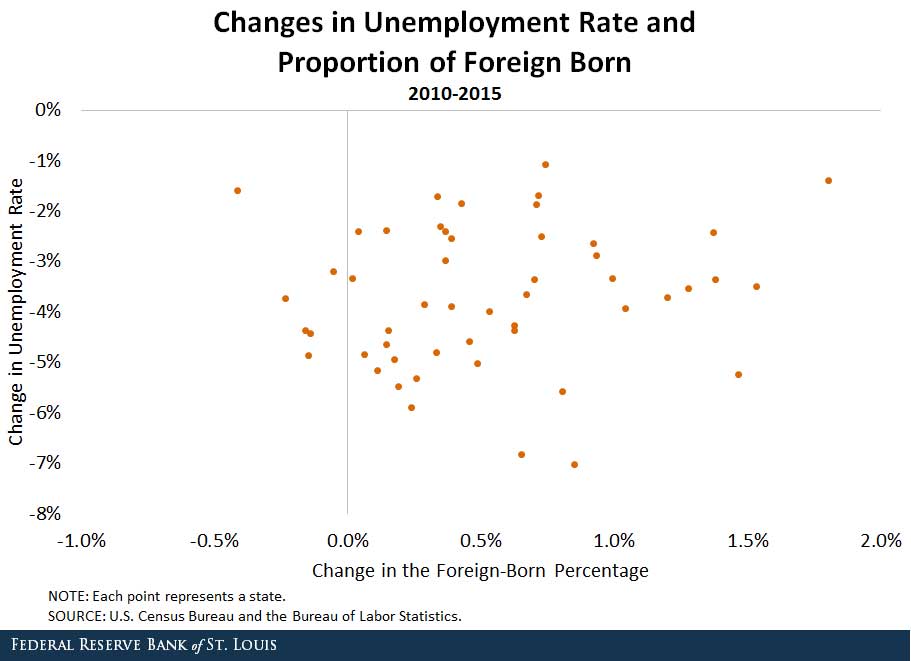Does Immigration Affect Local Labor Markets?

By Guillaume Vandenbroucke, Research Officer
Do waves of immigrants affect local labor markets? If so, how? This debate is often heated and needlessly confusing. It pays to look at data.
The census asks respondents where each member of their household was born. Respondents answer whether people were born in the United States (and in what state) or in a different country (and which one). Thus, a measure of immigration, namely the proportion of foreign born, can be constructed for each state.
The figure below shows how changes in the proportion of foreign born between 2010 and 2015 relate with changes in the rate of unemployment between the same dates. Each point represents a particular state.

The main message from the figure is that the correlation between the two variables is weak to nonexistent. For instance, many states experienced declines in their rates of unemployment of nearly 4 percentage points during this period. This coincided with a reduction in the proportion of foreign-born individuals for some states. For others, this coincided with an increase in the proportion of foreign born.
Immigration and Wages
Besides unemployment, there are, of course, other important measures of labor market outcomes, such as wages that workers receive in exchange for their labor. An analysis similar to the one described in the figure presented here also reveals a very weak correlation between immigration and wages across states.
Other Possible Effects?
Still, caution must prevail when interpreting the figure. Even though it is clear that the proportion of foreign born does not affect the overall rate of unemployment, it remains possible that some segments of the labor market are more affected than others. The figure is silent, for instance, about the unemployment rate of the least educated workers, local workers only or minority workers.
An interesting study by David Card discussed the effect of immigration on the wages and unemployment rate of the least skilled workers.1 The study looked at the “Mariel boatlift,” when about 125,000 Cubans emigrated from Cuba’s Mariel port to Miami between May and September 1980. Card found that, even though these immigrants were mostly low-skilled workers, low-skilled wages and the unemployment rate did not change in Miami.
What can explain such patterns in the data? The answer may be quite simple. For example, the unemployment rate should increase after an influx of immigrants if the number of jobs could not change, but, of course, it can. There were 76 million people in the United States in 1900, and there are 320 million nowadays. How could these “additional” people get jobs? Because there are more jobs.
Notes and References
1 Card, David. “The Impact of the Mariel Boatlift on the Miami Labor Market.” Industrial and Labor Relations Review, January 1990, Vol. 43, No. 2, pp. 245-257.
Additional Resources
- On the Economy: Did China’s One-Child Policy Really Have an Effect?
- On the Economy: Matching Jobs with the Right Skill Levels
- On the Economy: Where Are Immigrants to the U.S. Coming From?
Citation
ldquoDoes Immigration Affect Local Labor Markets?,rdquo St. Louis Fed On the Economy, Dec. 8, 2016.
This blog offers commentary, analysis and data from our economists and experts. Views expressed are not necessarily those of the St. Louis Fed or Federal Reserve System.
Email Us
All other blog-related questions

